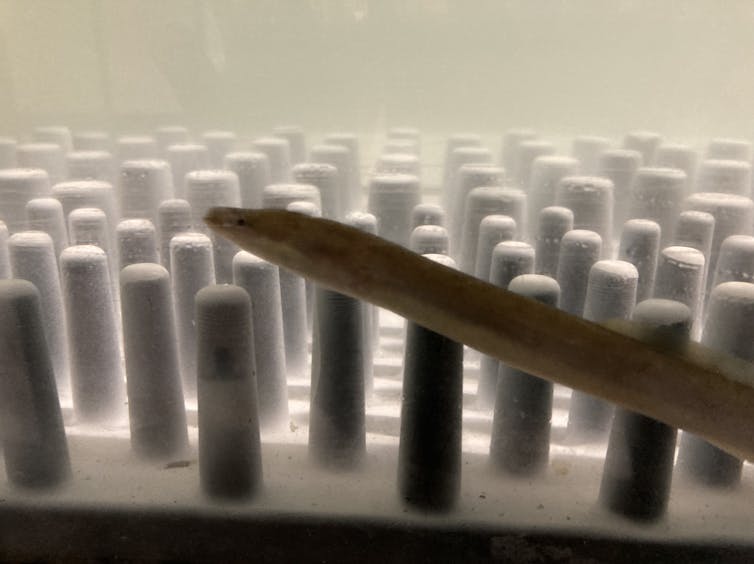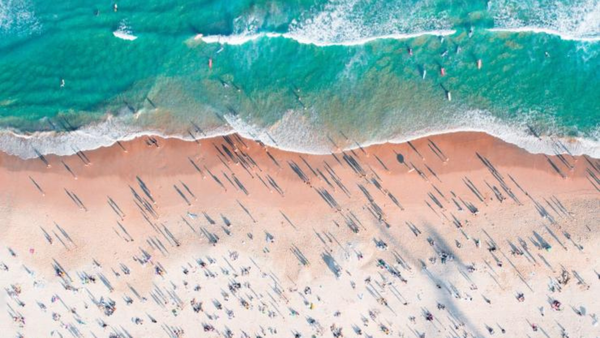The European eel Anguilla anguilla, a sleek, snake-like fish with a fascinating life cycle, once teemed in rivers. But their numbers have plummeted by over 95% since the 1980s.
Behind this dramatic decline is a combination of threats, including pollution, overfishing, and the fragmentation of rivers by human-made structures like dams and weirs.
But our new research has found a simple yet innovative way to help eels get past such obstructions: textured tiles.
The European eel is an anadromous fish, meaning that it is born and reproduces in saltwater but lives most of its life in freshwater. These fish are born in the Sargasso Sea, off the eastern coast of the US, and resemble small transparent leaves at this stage.
Around two years of age, these tiny eels are transported by ocean currents towards Europe. They then disperse to the Baltic Sea and the Mediterranean. When they reach brackish waters, they move towards the source of freshwater. At this stage, they are weak swimmers and primarily rely on the tides to transport them into rivers by hiding when the tide goes out and appearing when the tide comes in.
As they grow, they start making their way inland by swimming, climbing and crawling on land. Eels are capable of being out of water for several hours and crawl on land to get around obstacles. Eels in freshwater go through several life stages, from glass eels, to elvers, to yellow eels and finally silver eels with a size of around 80cm.
At this stage, they start to undergo changes to prepare them for their voyage back to the Sargasso Sea. This is a 4,000-mile journey that will take them two or more years. Eels only develop their reproductive organs when migrating back to the Sargasso Sea, which is why their reproduction was one of the science’s enduring mysteries.
When they reach the Sargasso Sea, the eels reproduce and die. Global warming shifting oceanic currents, invasive parasitic species, polluted rivers and illegal over-fishing are some of the reasons for this decline. Another reason is the fragmentation of rivers, which is the disconnection of rivers by human structures.
For fish species like salmon, or in eel in this case, that need to migrate up and down rivers throughout their life, these barriers in rivers can prevent them from migrating. This lowers their chances of completing their life cycle.
It is thought that there could be as many as 5 million human-made barriers in Europe that disrupt fish movements. Most of them are unidentified, but they mainly consist of dams, weirs, sluices, tidal gates and culverts.
Textured tiles
Our research concentrated on finding ways to help eels get past these sorts of obstructions while they swim up rivers as young eels. We found that textured tiles designed to help eels climb up weirs can also be used in situations where the flow is simply too fast for the eels to swim against.
The tiles, provided by the Environment Agency, consist of a square base with several cylinders protruding from it. The tiles function in two main ways to help the eels migrate upstream where the flow is too fast and there is no refuge.
First, they provide cover for the eels to rest or crawl by pushing against the cylinders. And second, they slow down the water flow passing through them, above them and to their side.

In a series of experiments, the eels could swim up our laboratory river more often and using less energy with the tiles present. And the tiles only need to cover a portion of the channel to be effective. This leaves the rest of the channel free for fish species that don’t need them. This solution is not only effective, but also cheap and easy to install in places like culverts and under road crossings, which makes it affordable to reconnect rivers for fish migration.
There are many other fish species that struggle to move around rivers because of human obstructions. That is where our latest research is focused. In our latest tests, other fish species are showing promising early results in using the tiles despite being much smaller and slower swimmers.
The next steps in transferring this research to the real world is to test these tiles in real rivers to see how different species of fish use them.
Our goal is to help all affected fish to pass up and down rivers as they require. This would be positive for biodiversity and ecosystem health, as well as improving fish stocks.

Don’t have time to read about climate change as much as you’d like?
Get a weekly roundup in your inbox instead. Every Wednesday, The Conversation’s environment editor writes Imagine, a short email that goes a little deeper into just one climate issue. Join the 30,000+ readers who’ve subscribed so far.
Guglielmo Sonnino Sorisio receives funding from NERC.
Catherine Wilson receives funding from the EPSRC, the Environment Agency, Severn Rivers Trust and Shropshire Council. She is a member of the Welsh Government's Flood Coastal Erosion Committee.
This article was originally published on The Conversation. Read the original article.







